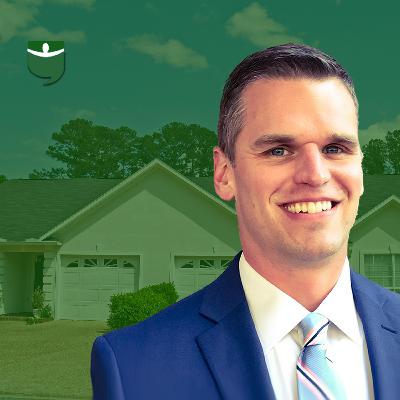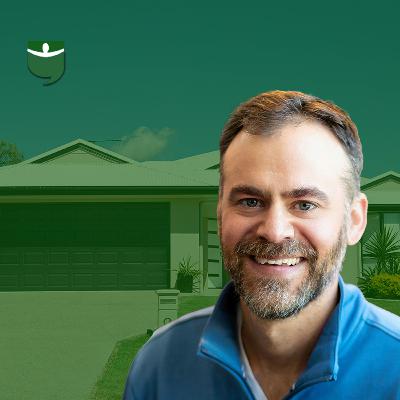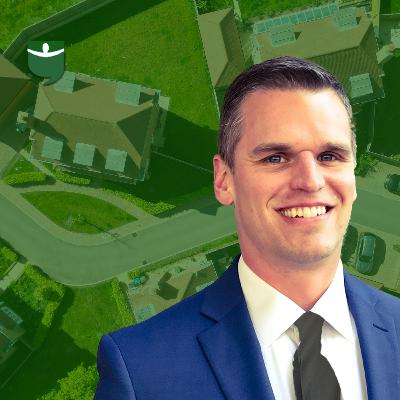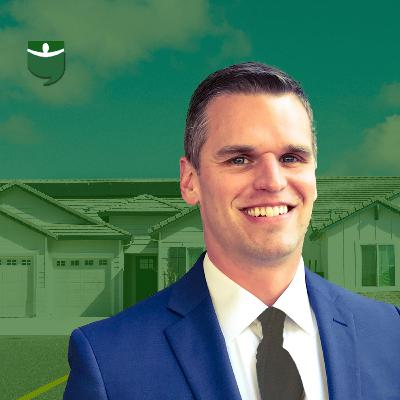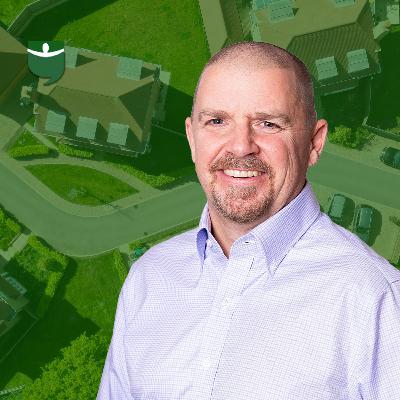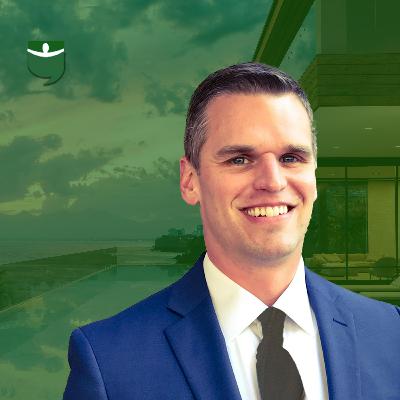Discover PassivePockets: The Passive Real Estate Investing Show
PassivePockets: The Passive Real Estate Investing Show

PassivePockets: The Passive Real Estate Investing Show
Author: PassivePockets, Jim Pfeifer, and Left Field Investors
Subscribed: 108Played: 5,235Subscribe
Share
© PassivePockets
Description
Welcome to PassivePockets: The Passive Real Estate Investing Show presented by Equity Trust– your go-to podcast for building and protecting wealth through smart, passive real estate investments. Hosted by Jim Pfeifer, this podcast is designed for investors who want to grow without the grind. Each episode features expert interviews with seasoned LPs (Limited Partners) and GPs (General Partners) who share their insights, experiences, and practical advice.
300 Episodes
Reverse
Jim Pfeifer and Chris Lopez sit down with investor and author J Scott to recap 2025 and map out what LPs should be watching in 2026. J shares where the year defied expectations (supply, rates, and “real” distress), how he’s positioning for a higher-for-longer rate regime, and the simple filters he’s using to decide between equity and credit today. The conversation covers underwriting discipline, liquidity planning, and why needs-based real estate and inefficient small-multifamily niches may offer the best risk-adjusted plays right now—if you partner with true specialists.
Key Takeaways
2025 reality check: distress was uneven and narrower than headlines; construction delays kept deliveries elevated longer than expected
Rates vs. cap rates: in higher-for-longer, appreciation must come from income growth and operational upside—not cap rate fantasy
Allocation: build durable cash flow with selective debt strategies while reserving dry powder for high-conviction equity dislocations
LP playbook: diversify by sponsor and strategy, avoid tax-driven decisions, and stress test for flat/negative rent growth and refi risk
Where to hunt: needs-based real estate (e.g., senior/medical/data) and imperfect small-multifamily markets where operator edge matters
Operator diligence: prioritize track record, reporting, and downside plans; verify fee alignment and who truly controls execution
Disclaimer
The content of this podcast is for informational purposes only. All host and participant opinions are their own. Investment in any asset, real estate included, involves risk, so use your best judgment and consult with qualified advisors before investing. You should only risk capital you can afford to lose. Past performance is not indicative of future results. This podcast may contain paid advertisements or other promotional materials for real estate investment advisers, investment funds, and investment opportunities, which should not be interpreted as a recommendation, endorsement, or testimonial by PassivePockets, LLC or any of its affiliates. Viewers must conduct their own due diligence and consider their own financial situations before engaging with any advertised offerings, products, or services. PassivePockets, LLC disclaims all liability for direct, indirect, consequential, or other damages arising out of reliance on information and advertisements presented in this podcast.
Chris Lopez and Paul Shannon welcome investor and author Brian Burke to look back at 2025 and set the table for 2026. Brian recaps his “end the dive in 25” thesis, explains why his pivot to senior housing has outperformed, and shares what actually surprised him this year. The group digs into supply, sentiment, and rates, plus the difference between perfect and imperfect markets and why small multifamily and true needs-based real estate may offer the best risk-adjusted plays right now.
Key Takeaways
2025 recap: senior housing led commercial performance while multifamily price declines slowed but did not fully reverse
Surprise of the year: new construction deliveries in multifamily stayed elevated longer than expected, keeping pressure on rents and occupancy
Portfolio moves: Brian co-invested in his senior housing fund, added selectively to individual stocks on pullbacks, explored biotech, and is eyeing Bitcoin on deeper dips
2026 watchlist: investor sentiment in multifamily, supply tapering, and the rate story split between short-term SOFR and the stubborn 10-year
Strategy notes: in a higher-for-longer world, appreciation must come from income growth more than cap rate compression
For LPs: prioritize needs-based real estate like senior housing, medical office, and data centers; consider contrarian but expert-led office plays and inefficient small-multifamily opportunities
Disclaimer
The content of this podcast is for informational purposes only. All host and participant opinions are their own. Investment in any asset, real estate included, involves risk, so use your best judgment and consult with qualified advisors before investing. You should only risk capital you can afford to lose. Past performance is not indicative of future results. This podcast may contain paid advertisements or other promotional materials for real estate investment advisers, investment funds, and investment opportunities, which should not be interpreted as a recommendation, endorsement, or testimonial by PassivePockets, LLC or any of its affiliates. Viewers must conduct their own due diligence and consider their own financial situations before engaging with any advertised offerings, products, or services. PassivePockets, LLC disclaims all liability for direct, indirect, consequential, or other damages arising out of reliance on information and advertisements presented in this podcast.
Give Us Your Ideas For Next The PassivePockets Summit!
https://docs.google.com/forms/d/1vwcvF1z03HYiKmR3a4JN8up0ja4kgKPzG2bCGS6640c/viewform?edit_requested=true
This Episode
It’s the November PassivePockets Pulse Check. Jim Pfeifer, Paul Shannon, and Chris Lopez share what’s new in their portfolios, the real impact of the Fed’s second rate cut, the tool you should use this month (sponsor reviews—now updatable), and how they’re setting concrete goals for 2026. Plus: a big announcement: PassivePockets Summit is in Denver, April 30 (arrival) - May 2. Vote on sessions and networking ideas via the survey in the link above.
Key Takeaways
Portfolio check: capital back from an Aspen Funds industrial deal (tribe structure), 30% return of capital from a Threefold sale, and an unfortunate likely loss tied to the DJE/Ascent situation, why operator integrity and transparency matter
Real deals in motion: Paul’s Indiana acquisition fully subscribed (rate locked), and an Evansville 56-unit true-distress LOI/PSA walkthrough (what those terms mean and why the team thinks it’s a fast operational turn)
Rates: two cuts this fall (~50 bps total) boosted sentiment but barely moved longer-term agency debt; example: 7-yr Treasury + spread shifted only ~6 bps between application and lock
Outlook: expect a trickle, not a tsunami, of distress into 2026 as “extend & pretend” maturities roll; bid/ask is narrowing, which may push lenders to act
Tools & goals: update your Sponsor Reviews (and why “update” notes help the community); Chris is rebalancing toward private credit and Roth-powered compounding, Jim is doubling down on trusted operators and liquidity discipline, and Paul is rotating from cash/metals into equity while keeping a family financial “in case of emergency” plan current
Disclaimer
The content of this podcast is for informational purposes only. All host and participant opinions are their own. Investment in any asset, real estate included, involves risk, so use your best judgment and consult with qualified advisors before investing. You should only risk capital you can afford to lose. Past performance is not indicative of future results. This podcast may contain paid advertisements or other promotional materials for real estate investment advisers, investment funds, and investment opportunities, which should not be interpreted as a recommendation, endorsement, or testimonial by PassivePockets, LLC or any of its affiliates. Viewers must conduct their own due diligence and consider their own financial situations before engaging with any advertised offerings, products, or services. PassivePockets, LLC disclaims all liability for direct, indirect, consequential, or other damages arising out of reliance on information and advertisements presented in this podcast.
Chris Lopez and Paul Shannon sit down with investor and educator Julie Holly for a candid conversation about wins, losses, and leadership as an LP and GP. Julie traces her path from house hacking to syndications, shares the “receive & release” mindset she uses to process setbacks, and explains what changed in her underwriting and operator vetting after a tough year, including one deal where mismanagement led to a total loss. They cover how LPs should share accountability, the exact questions to ask sponsors (who underwrites, how they stress-test, and how they communicate), and why Julie paused new offerings to focus on stewardship and transparency.
Key Takeaways
Start as an LP to learn the experience end-to-end; early distributions can feel great, but plans must survive rate, insurance, and market shifts
“Receive & release”: make space to process losses, own your part, then offload what isn’t yours so you can lead and decide clearly
Trust and verify: dig into vacancy, taxes, insurance, payroll, and who actually underwrites (in-house vs. outsourced/AI); stress-test more than one way
Accountability is shared: GPs must report clearly and often; LPs must understand their risk profile, read docs, and avoid “write first, learn later” FOMO
Choose relationships, not just returns: invest with people who answer candidly, welcome hard questions, and are reachable when things get bumpy
Disclaimer
The content of this podcast is for informational purposes only. All host and participant opinions are their own. Investment in any asset, real estate included, involves risk, so use your best judgment and consult with qualified advisors before investing. You should only risk capital you can afford to lose. Past performance is not indicative of future results. This podcast may contain paid advertisements or other promotional materials for real estate investment advisers, investment funds, and investment opportunities, which should not be interpreted as a recommendation, endorsement, or testimonial by PassivePockets, LLC or any of its affiliates. Viewers must conduct their own due diligence and consider their own financial situations before engaging with any advertised offerings, products, or services. PassivePockets, LLC disclaims all liability for direct, indirect, consequential, or other damages arising out of reliance on information and advertisements presented in this podcast.
In this exclusive webinar release, Paul Shannon moderates a market check with brokers Beau Beery, Reid Bennett, and Jakob Andersen. The panel covers where multifamily deals are actually clearing in late 2025, why the bid ask gap is narrowing, and how underwriting has shifted from headline cap rates to year one cash on cash, DCR, and debt yield. They compare Sunbelt supply waves to steadier Midwest fundamentals, walk through valuation reality checks sellers must face, and explain why most 2026 activity will be motivated sales and selective distress rather than a fire sale. The group also digs into operational costs, staffing shortages, financing paths into 2026, and what LPs should demand from GPs.
Key Takeaways
Bid ask is closing as loan maturities force decisions and rate volatility calms enough for buyers to plan
Underwrite to cash on cash, DCR, debt yield first and sanity check taxes, insurance, payroll, and true vacancy before quoting a cap rate
Supply matters more at scale: heavy Sunbelt deliveries pressure B assets while Midwest occupancy stays supported by limited new B stock and tight single family inventory
Financing mix for 2026 will be agency for stabilized and selective bridge for assets that cannot qualify, with realistic reserves and timelines
Expect more transactions and some distress in 2026, but not a broad capitulation; LPs should vet operators with downturn experience and transparent decision trees on sell, refi, or hold
Disclaimer
The content of this podcast is for informational purposes only. All host and participant opinions are their own. Investment in any asset, real estate included, involves risk, so use your best judgment and consult with qualified advisors before investing. You should only risk capital you can afford to lose. Past performance is not indicative of future results. This podcast may contain paid advertisements or other promotional materials for real estate investment advisers, investment funds, and investment opportunities, which should not be interpreted as a recommendation, endorsement, or testimonial by PassivePockets, LLC or any of its affiliates. Viewers must conduct their own due diligence and consider their own financial situations before engaging with any advertised offerings, products, or services. PassivePockets, LLC disclaims all liability for direct, indirect, consequential, or other damages arising out of reliance on information and advertisements presented in this podcast.
Dave Meyer joins Chris Lopez and Jim Pfeifer to unpack the shift from hands-on house hacking in Denver to diversified passive investing. Dave walks through selling select rentals, using a Delaware Statutory Trust for a 1031, and why he caps real estate time at 20 hours a month. He explains dollar cost averaging into syndications for liquidity management, why he still concentrates on multifamily he understands, and how he hedges with fixed-rate debt, cash, and some gold. The crew digs into operator selection, supply awareness, return-to-office tailwinds in core tech markets like Seattle, and the trap of chasing door count instead of clear goals.
Key Takeaways
Control, liquidity, taxes: define your time budget, ladder commitments, and decide when to pay tax versus use a DST
Dollar cost averaging works in private deals too: one allocation per year can smooth illiquidity and vintage risk
Invest in what you understand: pick operators first, then asset class, and underwrite local supply and rent comps
Hedge the cycle with structure: favor fixed-rate debt, bigger reserves, and realistic hold times over rosy exit timing
Strategy before scale: set goals for cash flow versus equity growth, then judge opportunities against those goals
Disclaimer
The content of this podcast is for informational purposes only. All host and participant opinions are their own. Investment in any asset, real estate included, involves risk, so use your best judgment and consult with qualified advisors before investing. You should only risk capital you can afford to lose. Past performance is not indicative of future results. This podcast may contain paid advertisements or other promotional materials for real estate investment advisers, investment funds, and investment opportunities, which should not be interpreted as a recommendation, endorsement, or testimonial by PassivePockets, LLC or any of its affiliates. Viewers must conduct their own due diligence and consider their own financial situations before engaging with any advertised offerings, products, or services. PassivePockets, LLC disclaims all liability for direct, indirect, consequential, or other damages arising out of reliance on information and advertisements presented in this podcast.
The Passive Pockets Pulse Check returns with Chris Lopez, Jim Pfeifer, and Paul Shannon. They break down what they bought and what they skipped, how they are reallocating between equity and debt, and the checks they run before wiring capital. Jim shares two new allocations in healthcare and coffee after negotiating a lower minimum for the community and explains invoking the Shirky rule to avoid doubling up with a new operator too quickly. Paul outlines a simple Indiana cash flow deal, a 22-unit JV turnaround, and an LP win with a partial disposition. Chris walks through a shift toward debt funds, a strong payout month, and a cautionary development story that highlights why transparency, lender diligence, and sponsor communication matter. The trio then uses the PassivePockets Deal Analyzer to spot red flags and assess IRR partitioning before deconstructing a friends and family hotel conversion with fee bloat, phantom equity, and misaligned waterfalls so you know when to pass fast.
Key Takeaways
Use investing clubs to test new managers or asset classes and always ask about minimums
Rebalance deliberately toward a mix of equity and debt while accounting for ordinary income taxes on debt yields outside retirement accounts
Multifamily is stabilizing in select markets, but underwrite with longer debt terms, larger reserves, and realistic rent and occupancy assumptions
Watch for fee-heavy structures, annual-only distributions, deferred development fees counted as equity, and dual waterfalls that dilute LP returns
The Deal Analyzer surfaces out-of-range assumptions and IRR partitioning shows how much return comes from operations versus exit
Disclaimer
The content of this podcast is for informational purposes only. All host and participant opinions are their own. Investment in any asset, real estate included, involves risk, so use your best judgment and consult with qualified advisors before investing. You should only risk capital you can afford to lose. Past performance is not indicative of future results. This podcast may contain paid advertisements or other promotional materials for real estate investment advisers, investment funds, and investment opportunities, which should not be interpreted as a recommendation, endorsement, or testimonial by PassivePockets, LLC or any of its affiliates. Viewers must conduct their own due diligence and consider their own financial situations before engaging with any advertised offerings, products, or services. PassivePockets, LLC disclaims all liability for direct, indirect, consequential, or other damages arising out of reliance on information and advertisements presented in this podcast.
Host Paul Shannon sits down with Gino (of Jake & Gino) to trace the path from family pizza shop to operating ~1,900 units with no outside equity. Gino breaks down why they paused syndications after 2019, how “PPU—profit per unit” drives their buy/hold decisions, and the exact LP diligence framework he wishes he’d had before losing money as a passive. They dig into today’s tighter credit, catching-a-falling-knife rent/occupancy dynamics, and why longer debt runways and operator fit matter more than ever.
Key Takeaways:
The LP Framework: Jockey (sponsor) → Saddle (alignment of interests) → Horse (deal: buy right, manage right, finance right)
Why they exited syndications: control, long-hold strategy, and avoiding the “feed the beast” pressure—investor expectations make investors your de facto bosses
Diligence like a pro: visit the asset, run the PPM through AI, then spend an hour with a securities attorney before wiring a dime
Operate for durability: target $200–$400 PPU, prefer vertical integration, and secure ≥5-year debt to bridge cycles
Match strategy to you: know your relationship with money, stagger commitments (the “conveyor belt”), and choose sponsors aligned with long-term holds if that’s your goal
Disclaimer
The content of this podcast is for informational purposes only. All host and participant opinions are their own. Investment in any asset, real estate included, involves risk, so use your best judgment and consult with qualified advisors before investing. You should only risk capital you can afford to lose. Remember that past performance is not indicative of future results. This podcast may contain paid advertisements or other promotional materials for real estate investment advisers, investment funds, and investment opportunities, which should not be interpreted as a recommendation, endorsement, or testimonial by PassivePockets, LLC or any of its affiliates. Viewers must conduct their own due diligence and consider their own financial situations before engaging with any of the advertised offerings, products, or services. PassivePockets, LLC disclaims all liability for direct, indirect, consequential, or other damages arising out of reliance on information and advertisements presented in this podcast.
Paul Shannon sits down with lender-turned-operator Ryan Duff to unpack how lenders really size risk and how LPs can use the same lens. Ryan financed ~$4B+ across cycles before launching Seaport, and he explains why trailing 3–6 month economic occupancy (physical vacancy + concessions + loss-to-lease) tells you more than any glossy OM. Join us to dive into debt yield, DSCR reality vs. pitch decks, the broker-driven “falsified inputs” fiasco and subsequent lender cleanup, and why he prioritizes local, vertically integrated operators with disciplined leverage and cash buffers.
Key Takeaways:
Underwrite like a lender: focus on economic occupancy (vacancy, concessions, loss-to-lease), not just IRR/EM multiples
Expenses are mostly knowable; deals are won/lost on the top-line and honest reporting of rent integrity
Debt terms follow the inputs: DSCR, debt yield, and recent trailing performance drive survivability
Protect yourself: vet the GP first (local, cycled deals, vertical ops, conservative leverage, transparency)
Industry shift: tighter lender verification post-froth (less room for “massaged” rent rolls), more equity skin-in-the-game
Bridge debt isn’t evil, operator fit + execution speed must match the capital structure
Disclaimer
The content of this podcast is for informational purposes only. All host and participant opinions are their own. Investment in any asset, real estate included, involves risk, so use your best judgment and consult with qualified advisors before investing. You should only risk capital you can afford to lose. Remember that past performance is not indicative of future results. This podcast may contain paid advertisements or other promotional materials for real estate investment advisers, investment funds, and investment opportunities, which should not be interpreted as a recommendation, endorsement, or testimonial by PassivePockets, LLC or any of its affiliates. Viewers must conduct their own due diligence and consider their own financial situations before engaging with any of the advertised offerings, products, or services. PassivePockets, LLC disclaims all liability for direct, indirect, consequential, or other damages arising out of reliance on information and advertisements presented in this podcast.
Host Chris Lopez and Paul Shannon talks with securities attorney Mauricio Rauld about the compliance landmines that trip up syndicators and how LPs can protect themselves. Mauricio shares why he exited his law firm to focus on education and “in-between” guidance (before the PPM), what an SEC lawyer actually does, and the real differences between 506(b) and 506(c). They cover LP recourse (rescission), how to diligence sponsors and structures (co-GPs, capital raisers, funds-of-funds), why “investment clubs” aren’t a loophole, and where regulations may head next (accreditation changes, a possible finder’s rule).
Key Takeaways:
Compliance isn’t “just a PPM”: most mistakes happen pre-attorney (emails, websites, social posts)
506(b) vs 506(c): advertising and accreditation verification are the two big pivots
LP protection: if securities laws are violated, rescission can force capital + interest returned
Capital raising rules: no transaction-based comp, substantial duties, and primary role ≠ fundraising
Trends to watch: FoF adviser/Investment Company Act issues, “investment club” myths, broader accredited paths and a potential finder rule
Disclaimer
The content of this podcast is for informational purposes only. All host and participant opinions are their own. Investment in any asset, real estate included, involves risk, so use your best judgment and consult with qualified advisors before investing. You should only risk capital you can afford to lose. Remember that past performance is not indicative of future results. This podcast may contain paid advertisements or other promotional materials for real estate investment advisers, investment funds, and investment opportunities, which should not be interpreted as a recommendation, endorsement, or testimonial by PassivePockets, LLC or any of its affiliates. Viewers must conduct their own due diligence and consider their own financial situations before engaging with any of the advertised offerings, products, or services. PassivePockets, LLC disclaims all liability for direct, indirect, consequential, or other damages arising out of reliance on information and advertisements presented in this podcast.
Host Chris Lopez sits down with Peter, an anesthesiologist who became an LP and then a GP, to unpack the career jolt that pushed him into real estate and the systems he built to bring more transparency and advocacy to LPs through Ascent Equity Group. Peter shares his first $5k crowdfunding check (and that unforgettable $47 distribution), lessons from launching in the tough 2021 vintage, and how his team handled rate/insurance shocks, lender work-outs, and communication when things got bumpy. We also dive into why he’s been using preferred equity in today’s market—including a 12.5–13.5% monthly-pay deal that returned capital in ~12 months and where he’s hunting now (hospitality, selective retail, and medical office) with a likely recession window following the Fed’s pivot.
Key Takeaways:
From OR to LP to GP: how a broken partnership promise sparked a plan for autonomy and passive income
Preferred equity in practice: monthly pay, collateralized position, and why it’s a “right now” tool—not forever
2021 lessons: short-term debt + fast-rising rates/insurance = humility, capital infusions, and relentless communication
Macro setup: Fed pivot → typical recession lag (~10–11 months) → prepare capital/relationships for distressed opportunities
What’s next: multifamily fundamentals (supply pause, sticky demand), selective hospitality/retail, and a special eye on medical office
Disclaimer
The content of this podcast is for informational purposes only. All host and participant opinions are their own. Investment in any asset, real estate included, involves risk, so use your best judgment and consult with qualified advisors before investing. You should only risk capital you can afford to lose. Remember that past performance is not indicative of future results. This podcast may contain paid advertisements or other promotional materials for real estate investment advisers, investment funds, and investment opportunities, which should not be interpreted as a recommendation, endorsement, or testimonial by PassivePockets, LLC or any of its affiliates. Viewers must conduct their own due diligence and consider their own financial situations before engaging with any of the advertised offerings, products, or services. PassivePockets, LLC disclaims all liability for direct, indirect, consequential, or other damages arising out of reliance on information and advertisements presented in this podcast.
Chris Lopez is joined by co-hosts Jim Pfeifer and Paul Shannon for the September PassivePockets Pulse Check, our monthly roundup of what’s moving passive real estate, the shifts we’re making in our own portfolios, and what we expect next.
We unpack the Fed’s recent 25 bps cut (what actually changes for fixed vs. floating debt), why many LPs are rotating toward private credit, and the rules-of-thumb we’re using right now for debt funds, multifamily, and development. Paul opens the hood on a heavy value-add 22-unit (50% vacant) targeting an ~11% yield-on-cost in an ~8 cap market, while Jim and Chris break down current debt yields, LTV guardrails, and how to think about liquidity. We also debut the Tool Tip of the Month and have a candid conversation about LP accountability, fraud vs. operator error vs. market risk, and how to use community to get smarter.
Disclaimer
The content of this podcast is for informational purposes only. All host and participant opinions are their own. Investment in any asset, real estate included, involves risk, so use your best judgment and consult with qualified advisors before investing. You should only risk capital you can afford to lose. Remember that past performance is not indicative of future results. This podcast may contain paid advertisements or other promotional materials for real estate investment advisers, investment funds, and investment opportunities, which should not be interpreted as a recommendation, endorsement, or testimonial by PassivePockets, LLC or any of its affiliates. Viewers must conduct their own due diligence and consider their own financial situations before engaging with any of the advertised offerings, products, or services. PassivePockets, LLC disclaims all liability for direct, indirect, consequential, or other damages arising out of reliance on information and advertisements presented in this podcast.
Host Chris Lopez sits down with John Bowens, CISP of Equity Trust to demystify Solo 401(k)s for real estate investors. John explains who actually qualifies, how to stack contributions up to $70k/$77.5k/$81,250 (2025 limits) and use the “mega backdoor” to Roth, and why Solo 401(k)s can avoid UBIT on debt-financed syndications when IRAs often can’t. They get tactical on plan design- one bank account with clean source tracking, blending traditional + Roth into a single subscription (and later in-plan conversions), and exactly how to roll over or restate a plan without triggering a termination. John also breaks down spouse/child participation, controlled-group and W-2 pitfalls, and a real UBIT case study that shows how the right plan choice can save five figures in tax.
Key Takeaways:
Solo 401(k) eligibility: true self-employment income and no rank-and-file W-2s; spouse/partners OK, under-21 and part-time hour rules matter
Higher limits + mega backdoor Roth: employee non-deductible → in-plan Roth conversion for bigger tax-free growth
UBIT advantage: Solo 401(k)s are generally exempt from UDFI/UBIT on debt-financed real estate (IRAs are not)
Simpler operations: one bank account, source tracking in software, and the ability to blend trad + Roth in one deal and convert later
Do rollovers right: restate/transfer the plan (don’t “terminate”), mind Form 5500, and watch controlled-group attribution
Disclaimer
The content of this podcast is for informational purposes only. All host and participant opinions are their own. Investment in any asset, real estate included, involves risk, so use your best judgment and consult with qualified advisors before investing. You should only risk capital you can afford to lose. Remember that past performance is not indicative of future results. This podcast may contain paid advertisements or other promotional materials for real estate investment advisers, investment funds, and investment opportunities, which should not be interpreted as a recommendation, endorsement, or testimonial by PassivePockets, LLC or any of its affiliates. Viewers must conduct their own due diligence and consider their own financial situations before engaging with any of the advertised offerings, products, or services. PassivePockets, LLC disclaims all liability for direct, indirect, consequential, or other damages arising out of reliance on information and advertisements presented in this podcast.
Host Chris Lopez sits down with Matt Faircloth, author of Raising Private Capital and co-founder of DeRosa Group, to talk hotels, multifamily, and building cash flow today while creating upside for tomorrow.
Matt breaks down why he is adding branded hotels to complement multifamily, how a 9 cap can deliver day one cash flow, and what the real risks are. He also shares simple paths for 1031 sellers to go passive without sacrificing tax advantages.
You will hear real numbers from his 96 key Houston hotel, how he structures A, B, and C share classes, and where he sees quiet distress and better yields in the Midwest.
Key Takeaways:
Hotels can provide day one cash flow at higher caps
Multifamily still matters but value add must drive returns
Simple “lazy 1031” and TIC structures can move active owners passive
Use third party hotel management and plan for brand PIPs
Watch quiet distress and newer assets trading at 7 caps in overlooked markets
Disclaimer
The content of this podcast is for informational purposes only. All host and participant opinions are their own. Investment in any asset, real estate included, involves risk, so use your best judgment and consult with qualified advisors before investing. You should only risk capital you can afford to lose. Remember that past performance is not indicative of future results. This podcast may contain paid advertisements or other promotional materials for real estate investment advisers, investment funds, and investment opportunities, which should not be interpreted as a recommendation, endorsement, or testimonial by PassivePockets, LLC or any of its affiliates. Viewers must conduct their own due diligence and consider their own financial situations before engaging with any of the advertised offerings, products, or services. PassivePockets, LLC disclaims all liability for direct, indirect, consequential, or other damages arising out of reliance on information and advertisements presented in this podcast.
From chiropractor to running a billion dollar portfolio, Dan Handford joins hosts Paul Shannon and Chris Lopez to unpack how he scaled across multifamily, storage, car washes, hotels, and private debt. He shares why he invested as an LP in 80 plus deals to sharpen his GP playbook, how he allocates for durable returns, and where he is leaning today. You will hear candid lessons from floating rate pain, capital calls, investor communication, and why debt strategies and selective distress are front of mind.
Key Takeaways:
LP lens: transparency, steady updates, and tackling problems head on
Allocation: prioritize consistency over stretch returns, diversify across operators and asset types
Where he is leaning: private debt funds with liquidity and a coming Reg A option for smaller checks
Risk lessons: floating rate vs fixed rate, large reserves, when a capital call protects value
Outlook: bid ask spread, lender pressure, and a likely uptick in distress over the next year
Disclaimer
The content of this podcast is for informational purposes only. All host and participant opinions are their own. Investment in any asset, real estate included, involves risk, so use your best judgment and consult with qualified advisors before investing. You should only risk capital you can afford to lose. Remember that past performance is not indicative of future results. This podcast may contain paid advertisements or other promotional materials for real estate investment advisers, investment funds, and investment opportunities, which should not be interpreted as a recommendation, endorsement, or testimonial by PassivePockets, LLC or any of its affiliates. Viewers must conduct their own due diligence and consider their own financial situations before engaging with any of the advertised offerings, products, or services. PassivePockets, LLC disclaims all liability for direct, indirect, consequential, or other damages arising out of reliance on information and advertisements presented in this podcast.
Industrial syndicator Joel Friedland joins Paul Shannon to share 40 years of Chicago lessons and why he now buys with little to no debt. They break down a debt-light playbook, how that changes capital raises and returns, and the investor profile that prefers sleep-at-night income. Joel also details his off-market system, what makes a “perfect” small-bay building, and how he creates liquidity and plans succession.
Key Takeaways:
Debt-light strategy: target 0 to 30 percent LTV, current portfolio around 18 percent
Buy box: Chicago small-bay under 40k sf, 7 to 8 percent entry yield, triple-net, strong geometry, docks, power
Return drivers: cash coupon that grows with rent, long holds, depreciation and recapture awareness
Sourcing and liquidity: door-to-door outreach, mini fund closes fast then syndicate, investor exits via assignments, 754 step-up, Rule 144 after 12 months
Sponsor vetting: ask for a written succession plan and review loan docs, covenants, and recourse
Disclaimer
The content of this podcast is for informational purposes only. All host and participant opinions are their own. Investment in any asset, real estate included, involves risk, so use your best judgment and consult with qualified advisors before investing. You should only risk capital you can afford to lose. Remember that past performance is not indicative of future results. This podcast may contain paid advertisements or other promotional materials for real estate investment advisers, investment funds, and investment opportunities, which should not be interpreted as a recommendation, endorsement, or testimonial by PassivePockets, LLC or any of its affiliates. Viewers must conduct their own due diligence and consider their own financial situations before engaging with any of the advertised offerings, products, or services. PassivePockets, LLC disclaims all liability for direct, indirect, consequential, or other damages arising out of reliance on information and advertisements presented in this podcast.
Can blockchain make private real estate more accessible? Paul Shannon speaks with Larry Kalis and Tyler Vinson about tokenization for LPs. They cover TRIFs from American Digital Realty, how RE Tokens enables secondary trading after a one year lockup, and what changes for custody, liquidity, and tax reporting. If you know syndications but are new to tokenized assets, this is a simple, practical breakdown.
Key Takeaways:
What tokenization means for LPs, a digital wrapper of your fund or deal interest on a blockchain
Access and diversification with lower minimums and one consolidated K1
Liquidity path using Rule 144 and a secondary marketplace after 12 months
Operations and security, KYC and AML, custodied tokens, fiat or USDC distributions, burn and reissue if lost
Structure and risks, ADR’s fund of funds TRIFs on Stellar vs single asset tokens, tech partner and valuation cadence
Disclaimer
The content of this podcast is for informational purposes only. All host and participant opinions are their own. Investment in any asset, real estate included, involves risk, so use your best judgment and consult with qualified advisors before investing. You should only risk capital you can afford to lose. Remember that past performance is not indicative of future results. This podcast may contain paid advertisements or other promotional materials for real estate investment advisers, investment funds, and investment opportunities, which should not be interpreted as a recommendation, endorsement, or testimonial by PassivePockets, LLC or any of its affiliates. Viewers must conduct their own due diligence and consider their own financial situations before engaging with any of the advertised offerings, products, or services. PassivePockets, LLC disclaims all liability for direct, indirect, consequential, or other damages arising out of reliance on information and advertisements presented in this podcast.
How do serious LPs sharpen due diligence, avoid shiny objects, and stay liquid enough to pounce? In this PassivePockets Pulse Check kickoff, Jim Pfeifer and Paul Shannon welcome new co-host Chris Lopez to go behind the scenes on community-powered due diligence, share their written investing theses, and walk through real deals they’ve funded, across equity and debt, plus the wins, misses, and lessons that are guiding allocations right now.
You’ll hear why sponsors and deals must be vetted on separate tracks, how to post in the forums to actually get useful feedback (do the work first), and what a one-page annual plan looks like when timing is uncertain. Paul breaks down his barbell strategy, favoring newer assets with day-one cash flow, fixed-rate debt, and positive leverage, while Chris lays out “Don’t bet against America,” lots of small checks for diversification, and building both an equity ladder and a debt ladder to solve liquidity timing. We also cover why Class A, Build-to-Rent, and select development fit today’s supply picture, plus portfolio updates: debt funds, self-storage development, A-class multifamily, BTR in Ohio, Colorado development, and a distressed multifamily buy in Omaha.
Finally, we unpack hard lessons from deals gone wrong- GP infighting, alleged commingling/investigations, and a multi-layer ATM Ponzi - and the practical guardrails we’re using now (limit per sponsor, avoid overly broad operators and multi-layer structures, and lean on the community). We close with a sentiment check: more LOIs, hard earnest money returning, and early buyout interest on BTR - why we’re cautiously optimistic (call it a yellow light) and still keeping cash optionality.
Key Takeaways:
How to use the community for real due diligence (and the posting format that gets responses)
The separation between sponsor vetting and deal analysis and why both matter
A simple one-page annual investing plan for capital, asset classes, and operator targets
Paul’s “all-weather” barbell: newer assets, day-one cash flow, fixed-rate/positive leverage
Chris’s “Don’t bet against America,” many small checks, and building equity + debt ladders
Why Class A, Build-to-Rent, and select development can shine as new supply falls off
Recent allocations: debt funds, self-storage development, A-class MF, BTR Ohio, CO development, distressed MF Omaha
Pain points & lessons: GP disputes, alleged commingling/FBI actions, and a multi-layer ATM Ponzi
Risk controls that help: limit exposure per sponsor, start with small first checks, consider fund diversification
Market pulse: more LOIs, hard money back on the table, early PE interest, why it’s still a yellow light for now
Disclaimer
The content of this podcast is for informational purposes only. All host and participant opinions are their own. Investment in any asset, real estate included, involves risk, so use your best judgment and consult with qualified advisors before investing. You should only risk capital you can afford to lose. Remember that past performance is not indicative of future results. This podcast may contain paid advertisements or other promotional materials for real estate investment advisers, investment funds, and investment opportunities, which should not be interpreted as a recommendation, endorsement, or testimonial by PassivePockets, LLC or any of its affiliates. Viewers must conduct their own due diligence and consider their own financial situations before engaging with any of the advertised offerings, products, or services. PassivePockets, LLC disclaims all liability for direct, indirect, consequential, or other damages arising out of reliance on information and advertisements presented in this podcast.
What do billionaires know about investing that the average person doesn’t? In this episode, Paul Shannon sits down with economist, fund manager, and author Bob Fraser, author of Invest Like a Billionaire, to unpack the strategies, asset allocations, and decision-making frameworks of the ultra-wealthy.
Bob explains why billionaires aren’t chasing “hot” trends, they’re looking for asymmetric risk-reward opportunities and sectors that offer long-term compounding. He shares how they think about diversification (and why it’s not about owning a little of everything), why certain private investments are favored over public markets, and how billionaires position themselves to capitalize on economic shifts before they happen.
You’ll hear how Bob applies these principles in real estate, why he’s watching specific macroeconomic signals right now, and the filters investors can use to evaluate opportunities like the ultra-rich — even without a billionaire’s balance sheet.
Key Takeaways:
The mindset differences between billionaires and everyday investors
Why the ultra-wealthy prioritize asymmetric risk-reward setups
How billionaires view diversification vs. “diworsification”
The role of private investments and niche sectors in their portfolios
Economic indicators billionaires watch to stay ahead of market cycles
How to apply billionaire-style investing principles at any scale
Bob Fraser’s current outlook on real estate opportunities
Disclaimer
The content of this podcast is for informational purposes only. All host and participant opinions are their own. Investment in any asset, real estate included, involves risk, so use your best judgment and consult with qualified advisors before investing. You should only risk capital you can afford to lose. Remember that past performance is not indicative of future results. This podcast may contain paid advertisements or other promotional materials for real estate investment advisers, investment funds, and investment opportunities, which should not be interpreted as a recommendation, endorsement, or testimonial by PassivePockets, LLC or any of its affiliates. Viewers must conduct their own due diligence and consider their own financial situations before engaging with any of the advertised offerings, products, or services. PassivePockets, LLC disclaims all liability for direct, indirect, consequential, or other damages arising out of reliance on information and advertisements presented in this podcast.
We’re back with another episode of Dig In or Delete, where Jim Pfeifer and Paul Shannon react to real investment pitches from their inbox and decide whether each one is worth a deeper look or should be deleted on the spot.
This week’s lineup includes a six-property self-storage deal in Arkansas, a triple-net Starbucks opportunity with a 4.5% cap, and a cash-out refinance pitch for a 68-unit apartment building. Jim and Paul break down the good, the bad, and the questionable, offering LP investors a candid look at how seasoned pros filter their deal flow.
You’ll hear how they evaluate everything from leverage and cap rate to operator communication and downside protection and why most pitches get deleted without a second thought.
Key Takeaways:
How experienced LPs quickly filter incoming investment pitches
Red flags in deal presentations, underwriting, and language
Why triple-net deals aren’t always “passive” or low risk
What makes storage look appealing—and what might be missing
How debt structure and cash-out refinances affect risk profile
Why sponsor transparency is often more important than returns
What to ask before replying to a deal that lands in your inbox
How to build your own “delete” filter to save time and protect capital
Disclaimer
The content of this podcast is for informational purposes only. All host and participant opinions are their own. Investment in any asset, real estate included, involves risk, so use your best judgment and consult with qualified advisors before investing. You should only risk capital you can afford to lose. Remember that past performance is not indicative of future results. This podcast may contain paid advertisements or other promotional materials for real estate investment advisers, investment funds, and investment opportunities, which should not be interpreted as a recommendation, endorsement, or testimonial by PassivePockets, LLC or any of its affiliates. Viewers must conduct their own due diligence and consider their own financial situations before engaging with any of the advertised offerings, products, or services. PassivePockets, LLC disclaims all liability for direct, indirect, consequential, or other damages arising out of reliance on information and advertisements presented in this podcast.










